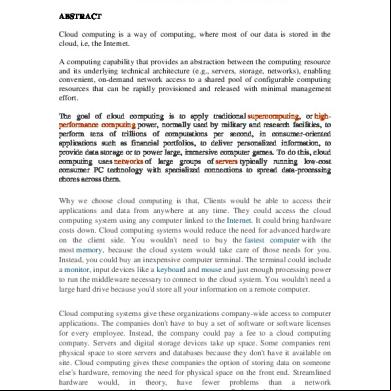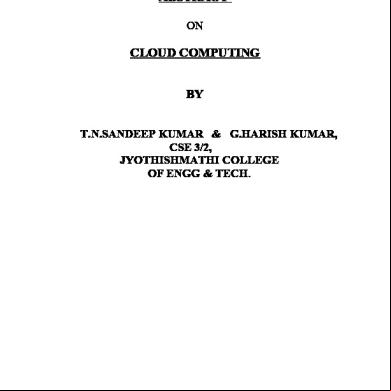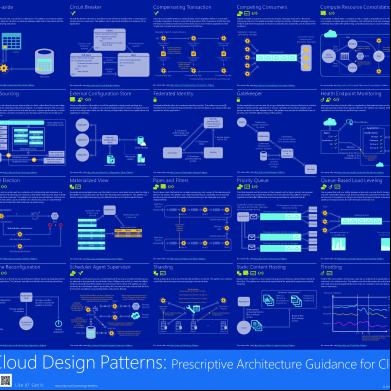Cloud Computing Seminar Abstract 4e257
This document was ed by and they confirmed that they have the permission to share it. If you are author or own the copyright of this book, please report to us by using this report form. Report 3b7i
Overview 3e4r5l
& View Cloud Computing Seminar Abstract as PDF for free.
More details w3441
- Words: 553
- Pages: 2
CLOUD COMPUTING ABSTRACT Cloud computing is a way of computing, where most of our data is stored in the cloud, i.e, the Internet. A computing capability that provides an abstraction between the computing resource and its underlying technical architecture (e.g., servers, storage, networks), enabling convenient, on-demand network access to a shared pool of configurable computing resources that can be rapidly provisioned and released with minimal management effort. The goal of cloud computing is to apply traditional supercomputing, or highperformance computing power, normally used by military and research facilities, to perform tens of trillions of computations per second, in consumer-oriented applications such as financial portfolios, to deliver personalized information, to provide data storage or to power large, immersive computer games. To do this, cloud computing uses networks of large groups of servers typically running low-cost consumer PC technology with specialized connections to spread data-processing chores across them. Why we choose cloud computing is that, Clients would be able to access their applications and data from anywhere at any time. They could access the cloud computing system using any computer linked to the Internet. It could bring hardware costs down. Cloud computing systems would reduce the need for advanced hardware on the client side. You wouldn't need to buy the fastest computer with the most memory, because the cloud system would take care of those needs for you. Instead, you could buy an inexpensive computer terminal. The terminal could include a monitor, input devices like a keyboard and mouse and just enough processing power to run the middleware necessary to connect to the cloud system. You wouldn't need a large hard drive because you'd store all your information on a remote computer. Cloud computing systems give these organizations company-wide access to computer applications. The companies don't have to buy a set of software or software licenses for every employee. Instead, the company could pay a fee to a cloud computing company. Servers and digital storage devices take up space. Some companies rent physical space to store servers and databases because they don't have it available on site. Cloud computing gives these companies the option of storing data on someone else's hardware, removing the need for physical space on the front end. Streamlined hardware would, in theory, have fewer problems than a network of heterogeneous machines and operating systems. Perhaps the biggest concerns about cloud computing are security and privacy.
REFERENCE. C. GONG, J. LIU, Q. ZHANG, H. CHEN, and Z. GONG, "The Characteristics of Cloud Computing", 39th IEEE international Conference on Parallel Processing Workshops 2010, IEEE Computer Society, pp. 275-279. P. MELL, and T. GRANCE, "Recommendations of the National Institute of Standards and Technology", National Institute of Standards and Technology, US Department of Commerce, January 2011. S. ZHANG, X. CHEN, and X. HUO, "Cloud Computing Research and Development Trend", IEEE Second International Conference on Future Networks 2010, pp. 93-97. L. ZHANG and Q. ZHOU, "CCOA: Cloud Computing Open Architecture", IEEE International Conference on Web Services 2009, IEEE Computer Society. Z. ZHANG, and X. ZHANG, "Realization of Open Cloud Computing Federation Based on Mobile Agent", IEEE International Conference on Intelligent Computing and Intelligent Systems, 2009. IEEE xplore Digital Library, pp. 642-646. B. GROBAUER, T. WALLOSCHEK, and E. STOCKER, "Understanding Cloud Computing Vulnerabilities", IEEE Security and Privacy, Volume: 9, Issue: 2, March-April 2011, pp. 50-57.
REFERENCE. C. GONG, J. LIU, Q. ZHANG, H. CHEN, and Z. GONG, "The Characteristics of Cloud Computing", 39th IEEE international Conference on Parallel Processing Workshops 2010, IEEE Computer Society, pp. 275-279. P. MELL, and T. GRANCE, "Recommendations of the National Institute of Standards and Technology", National Institute of Standards and Technology, US Department of Commerce, January 2011. S. ZHANG, X. CHEN, and X. HUO, "Cloud Computing Research and Development Trend", IEEE Second International Conference on Future Networks 2010, pp. 93-97. L. ZHANG and Q. ZHOU, "CCOA: Cloud Computing Open Architecture", IEEE International Conference on Web Services 2009, IEEE Computer Society. Z. ZHANG, and X. ZHANG, "Realization of Open Cloud Computing Federation Based on Mobile Agent", IEEE International Conference on Intelligent Computing and Intelligent Systems, 2009. IEEE xplore Digital Library, pp. 642-646. B. GROBAUER, T. WALLOSCHEK, and E. STOCKER, "Understanding Cloud Computing Vulnerabilities", IEEE Security and Privacy, Volume: 9, Issue: 2, March-April 2011, pp. 50-57.










